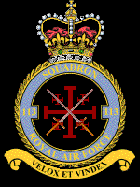
RAF 113 SQUADRON
W.O. John Reid
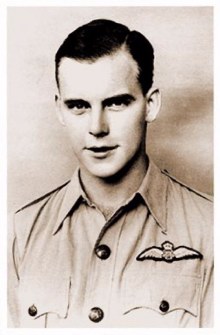
Pilot W.O John Reid, RAAF
Bicester was a Ferry pool in the UK providing crews for flying aircraft to the Middle East and Sgt Reid and his crew were one of these. The aircraft they had been given was Z7851, a Blenheim MK IV, which prior to departure they had became intimate with having flight tested, air tested, altitude tested, fuel consumption tested and etc. Not surprisingly, John notes they were seriously attached to Z7851 and were close to weeping tears of blood when they had to hand it over to the pool of aircraft in Egypt! "Departing the UK the staged flight would take them to Egypt via Gibralter and Malta, flying low on the water from Gib to Malta to avoid Vichy French Radar in French Algeria or Morocco. These were used by the French to advise the Italian fighter base on Pantelleria that another formation of ferry aircraft were on the way, so they could intercept. Also, radio silence was a must and the Germans on Sicily would listen continually for any aircraft unsure of position asking for a QDM to Malta and providing one immediately with a course to fly to Sicily, only a few degrees different. We arrived in Malta in an air raid and left Malta a couple of days later also in an air raid. The trap was that if your aircraft was destroyed or badly damaged you were posted immediately to a Blenheim or Maryland Squadron on Malta, to operate against Axis shipping crossing the Med to supply Rommel in North Africa. The future on these Ops was said to be somewhat uncertain! "
"I joined the Squadron on Christmas eve in 1941 in Helwan - Cairo. "Here the Squadron was regrouping after coming out from Giarabub in the desert after the Germans had clobbered most of their aeroplanes. Most making the trek back to Cairo rather ignoblessly in the back of transport choking on dust".
"At Helwan, which was a suburb of Cairo there was a big POW camp being used as a staging area, there was no aerodrome or aeroplanes, just a lot of blokes in tents".
"Immediately after joining we were told we were on our way to Singapore and as there were not enough aeroplanes, the new arrivals had to go by ship. We boarded the 'SS City Of Paris' at Suez on 13/01/1942 which was mostly occupied with Royal Marines but there was also quite a group of 113 Squadron on this trip of both air and ground crew. From Suez we left for Aden and from Aden on to Columbo arriving 02/02/1942. We left the ship at Columbo and went by train through India, up over the narrows at the top of Ceylon to the train ferry to cross the strait to the Southern tip of India, then by same train to Madras (Transit camp at Avadi) on 05/02/1942. Here we stayed at an army camp near Madras for awhile and then boarded the British India vessel the 'SS Neuralia' on 14/02/1942. The ship arrived in the river at Rangoon on Feb 21, 1942 (21/02/1942) where I celebrated my 21st birthday aboard ship. Having arrived just as our C/O was in the process of getting out of Rangoon ahead of the rapidly approaching Japs, he told us "the last thing I need is more aircrew, if they don't have aeroplanes I don't want them". With that they turned the ship around and headed all the way back to Madras arriving on 28/02/1942. From there we went up to Fyzabad (India) to an old Artillery Base where we met others from the squadron who had arrived following the retreat from Burma, many of these having hitched rides from Magwe back to Akyab then onto India". We left the Avadi Transit Camp by rail for Fyzabad, United Province, on 03/03/1942 arriving on 07/03/1942.
At Fyzabad, and scarcely a few months after the last time, once again the squadron would have to re-form due to severe losses of aircraft and men. This being a combination of the new arrivals and those survivors which were still trickling out of Burma. Hilariously, also once again, the new members of the squadron would not see aircraft. Sgt Reid remarks, "there were no aeroplanes here either, just a bunch of airmen without aeroplanes." ( Whats even more hilarious is at that very moment, little did Sgt Reid know, but the rest of the squadron hundreds of miles away still at Magwe were wondering the exact same thing!) The rest of the new comers to the squadron who had arrived at Rangoon before him, and had actually made it to the base in Toungoo, were also wondering where the squadrons aircraft were. Unknowingly they had arrived after the squadron had left, and likely due to the chaos and uncertainty at the time, were kept in the dark as to where the aircraft were and when they might become operational with them. Sgt Glyn Edwards states: "A queer war is this. We are all wondering where our Blenheims are, as not one of the squadron's planes have been seen, since our arrival .
"After re-forming we departed Fyzabad on 06/04/1942 and moved to a new base arriving at Asansol 08/04/1942 where finally for the first time since joining the squadron our aeroplanes miraculously appeared. On 11/04/1942 I did a 20 minute local flight. On 12/04/1942 I did a 1 hour local formation flight and on 16/04/1942 we flew to Lashio and Loiwing (China). These were our first flights since arrival in Egypt on 08/12/1941.
"Asansol was a railway town about 120 miles north west of Calcutta. The town was within walking distance and there was a nice central railway station where we used to go to eat. I recall there used to be a Holy Man who lived in a tree just as you walked down the main street, and of course, cows being sacred, they were just wandering about everywhere. There was a (spelling?) Jim Karna Club which belonged to the Anglo-Indians. These were nice folks, and being largely despised by both the British and the Indians, they made their own fun. We were actually billeted here initally in a Christian Brothers School, an industrial school where the kids learn woodwork, metal work and similar trades. This is the building where the famous cross was knocked off by Mike Ffoliette Foster, Mike nicknamed Tex, was on the same raid that I was shot down on. He was flying #2, I was flying #3. He was a Yank but I believe he was in the RCAF".
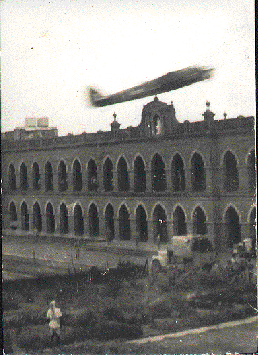 "As to the cross incident, I saw this happen. We were doing some Army Co-op at the time, beating up Army people doing exercises (beating up meaning, showing off, flying dangerously low, or pretend attacking) and as we came back from these or from a raid or what we called the Wog Recco's, (which is when the locals were acting up rioting and such, we used to have to go beat them up, without firing of course, except maybe Very lights if the situation warranted it), in any case it was our habit up untill that time to beat up the school or headquarters on returning to base. You would come up the valley and pull up and over the roof of the school barely clearing it just to let the boys know you were home. On this particular ocassion, Foster came back from whatever he was doing, likely a raid as I believe he still had bombs on, and as he pulled up over the school he hit the cement cross on top and did a proper job of it. He didn't damage his Blenheim much but he knocked the cross to smithereens and a couple of blokes down below nearly got clobbered by bits of falling masonry. I was standing up on one of the balconies of the school at the time. At this stage the CO then let it be known that he didn't think it was a good idea that we beat up the school anymore and strongly suggested we discontinue the practice......especially if we were still carrying bombs. Lorne Tapp was another who was a bit of a larrikin with an aeroplane, a good pilot and a nice guy. Both him and Tex were somewhat daredevils, and some of us were a bit more sedate". (I believe John is indicating he falls into the latter category, but I'm not so certain about that)
"As to the cross incident, I saw this happen. We were doing some Army Co-op at the time, beating up Army people doing exercises (beating up meaning, showing off, flying dangerously low, or pretend attacking) and as we came back from these or from a raid or what we called the Wog Recco's, (which is when the locals were acting up rioting and such, we used to have to go beat them up, without firing of course, except maybe Very lights if the situation warranted it), in any case it was our habit up untill that time to beat up the school or headquarters on returning to base. You would come up the valley and pull up and over the roof of the school barely clearing it just to let the boys know you were home. On this particular ocassion, Foster came back from whatever he was doing, likely a raid as I believe he still had bombs on, and as he pulled up over the school he hit the cement cross on top and did a proper job of it. He didn't damage his Blenheim much but he knocked the cross to smithereens and a couple of blokes down below nearly got clobbered by bits of falling masonry. I was standing up on one of the balconies of the school at the time. At this stage the CO then let it be known that he didn't think it was a good idea that we beat up the school anymore and strongly suggested we discontinue the practice......especially if we were still carrying bombs. Lorne Tapp was another who was a bit of a larrikin with an aeroplane, a good pilot and a nice guy. Both him and Tex were somewhat daredevils, and some of us were a bit more sedate". (I believe John is indicating he falls into the latter category, but I'm not so certain about that)Sgt John Reid and crew were one of those sent on detachment to China and was in formation with F/O Hickey when he crashed. Three of these crews known to be on the second flight out on the 16th were ( Sgt John Reid Pilot, Sgt Peter Wilson Obs, Sgt Lenny White Wop/Ag ), ( F/Sgt Max Hickey Pilot, F/Sgt Edgar Campbell Obs, F/O Ron Llewellyn Rogers Wop/Ag ) ( F/O Eric Pearse Pilot, F/O Colin Grigg Obs, F/Sgt Joe Germein Wop/Ag)
"We were sent to Loiwing from the (16/04/1942)16th of April 1942 untill the 20th (20/04/1942). On the 16th we flew out from Asansol to Lechim (sp?), Kelewa, Bhamo to Loiwing. On the same day we flew down to Lashio which was in the Northern Chin States south of Loiwing, the weather was bad however and we returned to Loiwing. Lashio was an RAF base and we got all our bombs here. On the 17th we flew back to Lashio and stayed overnight. On the following morning of the 18th we did an operation from Lashio to Magwe, Here we straffed and bombed the town and aerodrome while the AVG (American Volunteer Group) provided top cover, then returning to Lashio then back to Loiwing. On the 19th we flew out to Lashio then on to Allenmyo where we straffed and bombed with only two of us returning afterward to Lashio then back to Loiwing. The flight consisted of P/O Max Hickey, F/O Eric Pearse and myself., P/O Hickey was lost on this operation enroute to Allenmyo. There were the three of us in formation flying very low down the dry bed of a river aways then we swung left up out of the river bed over the bank and as we came up there were palm trees, pagodas, and such we had to lift up over. Banking into the turn I was highest up on the outside, F/O Pearse leading was in the middle, and P/O Max Hickey was lowest on the inside. Although watching the leader, I happened to catch Hickey's plane for an instant out of the corner of my eye and thought his left wing tip was bloody close to those palm trees and Padgoda's, then I saw it dip and it was gone from my field of vision. At the time there were Japanese troops on the road and we were taking ground fire from the area and whether he got hit by ground fire, or hit the top of a padgoda or tree I can't say. When we got back my Wop/Ag Sgt Lenny White said "yes I saw him go in, there was a huge cloud of dust, no sign of flame or explosion, just a pile of dust"
The entire crew was lost and F/Sgt Max Hickey Pilot, F/Sgt Edgar Campbell Obs and F/O Ron Llewellyn Rogers Wop/Ag were reported missing presumed dead.
"In another incident I recall, we were on our way back from a raid on Monywa when P/O McGlashen had engine trouble and was forced to ditch as we were coming into Dum Dum. I happened to look over and I could see McGlashen's aircraft getting steadily lower and lower and though geeze he's getting close to the water. Sure enough a few moments later I saw a plume of water and into the river he went. They weren't long climbing out of the aircraft and sat down on the wing."
When asked why McGlashen would not have communicated his difficulty to the others Sgt Reid replied; "The Blenheims did have intercom and we could talk amongst ourselves or with other aircraft but it was very crackly and we could only communicate with much difficulty. You couldn't rely on it. We also had communication with morse code through the WOp/Ag".
On 9 September 1942 (09/09/1942), Sgt John Reid and his crew flying Blenheim MKIV V5589 were engaged in an attack on enemy shipping which was reported to be in the Port at Akyab on the Western Burmese coast. The five Blenheims of 113 Squadron came in from the sea past Oyster Island and dropping to wave-top height they crossed the harbour through a barrage of flak from both ships and shore. During the run in his aircraft was hit by flack but continued to target the larger of the two ships, the D/S Hafthor (alias Niyo Maru) and eventually his observer, Peter Wilson, released their bombs, which struck the ship as Sgt Reid pulled his aircraft over the ship's mast.
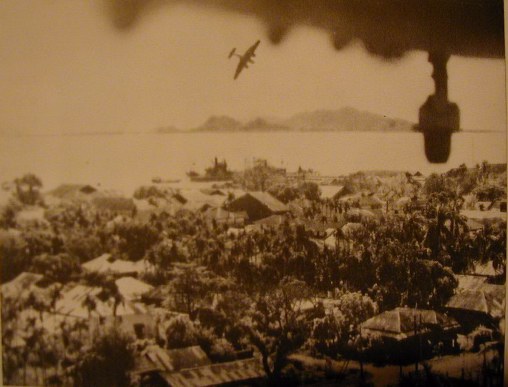 Japanese fighters then appeared and as he climbed towards cloud cover he was hit again in the port engine and began loosing power. When the Japanese fighters attacked, Sgt Reid took evasive action. "I put the aircraft into a stall turn cum wing-over reducing power on both engines as I did so, then applying full power as I pulled her out just above the water,"
Japanese fighters then appeared and as he climbed towards cloud cover he was hit again in the port engine and began loosing power. When the Japanese fighters attacked, Sgt Reid took evasive action. "I put the aircraft into a stall turn cum wing-over reducing power on both engines as I did so, then applying full power as I pulled her out just above the water,""The fighters seemed to have left us and I was just starting to breathe again when out of the corner of my eye, I saw a great glow in the port engine, streaming backwards, so I hit the fire extinguisher button, with no effect. Wing rivets were popping and plates flying off backwards. It seemed the whole caboodle would go sky high. "I decided to ditch the aircraft and we skimmed lower and lower and went slower and slower until we reached the point of stall just as the tail wheel hit the water and we ditched about four miles west of the island."
Despite being badly wounded, Sgt Reid's tail gunner, Sgt Len White, launched the dinghy and they drifted away from the sinking aircraft, heading for shore. The plan was to head to Cox's Bazaar which was at that time "patrol territory", hoping they'd meet an Allied patrol before a Japanese one. "In the event, we covered 17 miles in 22 hours before Arakanese villagers alerted the Japs to our progress up the Mayu.
"When we arrived in Akyab after our capture, the larger sunken ship was clearly visible – a lovely sight – from where we were held in the same building as the survivors from the sunken ship." Sgt Reid spent nearly the next three years in the hell of a Japanese prison camp and was released by the Royal Navy on May 3rd 1945. He then travelled to Calcutta aboard the hospital ship HMHS Kanchrapara where he was operated on for appendicitis enjoying three weeks of icecream and TLC from the Sisters.
The official extract from the Squadrons records reads:
09/09/1942 0915hrs, Two merchant ships were reported entering AKYAB last night and a large formation of Blenheims, 5 from 113 Squadron. 5 from 60 Squadron and 3 from 34 Squadron were despatched to attack them. The crews from 113 Squadron were W/Cdr Walter and crew, F/Sgt. Ffolliott-Foster and crew and Sgt Reid and crew, F/O Basingthwaite and crew and F/O Loane and crew. The attack was carried out from ultra-low-level and the ships and jetty were hit. Both ships were reported later in the day to have sunk and the jetty was badly damaged. As the aircraft left the target they were attacked by a large formation of enemy fighters and after a running fight of 20 minutes the fighters broke off and returned to their base. F/O Loane and crew and Sgt Reid and crew and one aircraft of 60 Squadron failed to return. F/O Bassingthwaite landed at DUM DUM but his aircraft was so badly damaged and shot up that he had to leave it there.
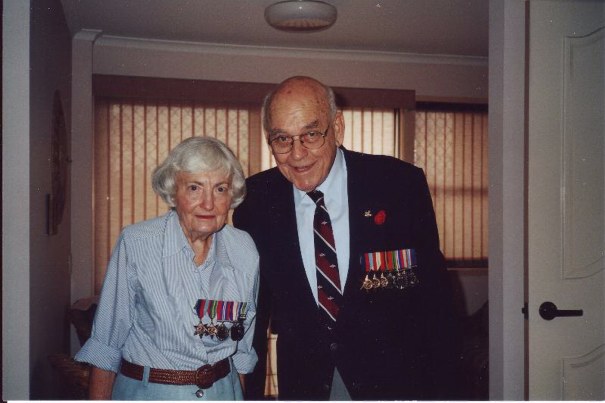
W.O John Reid and his wife taken on Anzac Day 2004
Johns wife served with the famous 2/6th Australian General Hospital then stationed at Labuan Island off the coast of Borneo. Labuan was a British colony. On 1st January 1942 the Japanese landed in Labuan with no resistance and took formal occupation of the island, later changing it''s name to Pulau Maida. North Borneo was liberated from the Japanese Occupation on 10th June 1945 when a Brigade of the Australian 9th Division landed on Labuan. This was supervised by General Douglas MacArthur and the United States 7th Fleet. John and his wife attended the 60th anniversary of the recapture of the Island and surrender of the japanese.
BACK TO WO John Reid listing || BACK TO SQUADRON PERSONNEL
